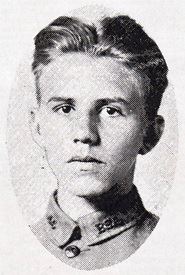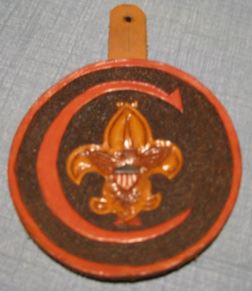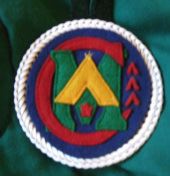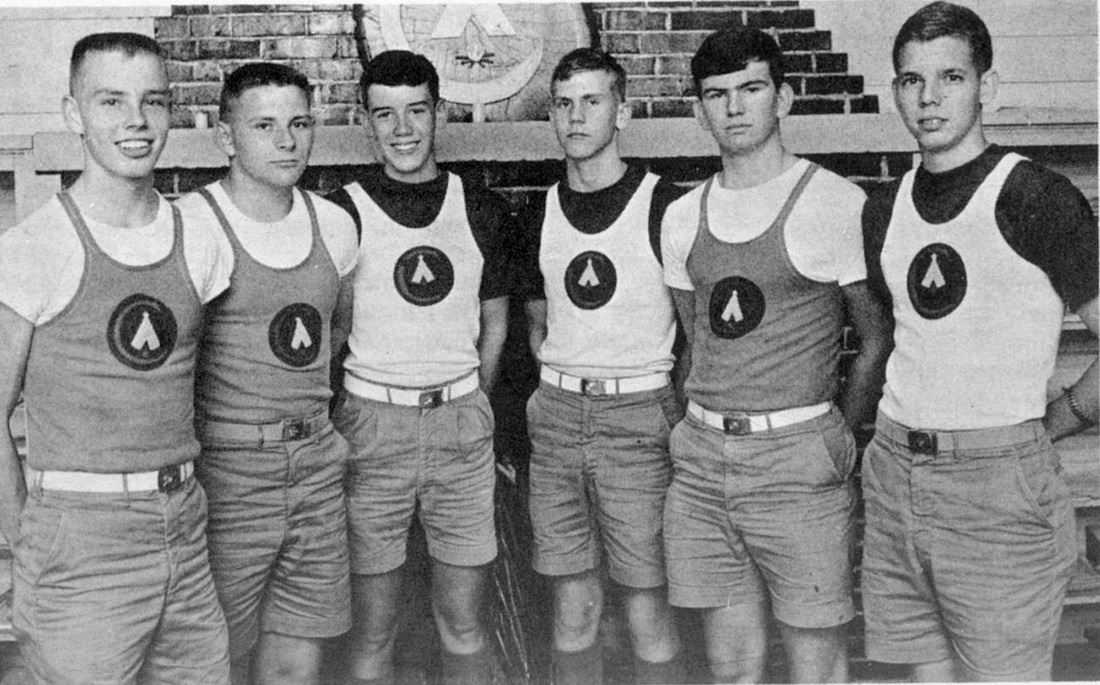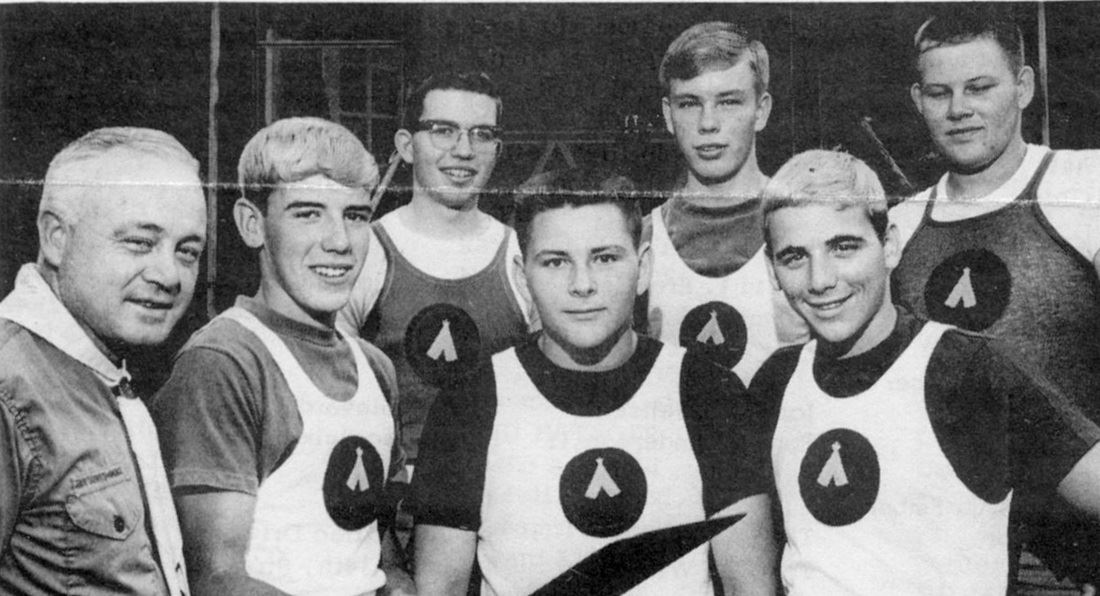Firecrafter: Building the Foundation (Leadership and Expansion 1920-1960)
As the Firecrafter membership grew in the early ‘20's, officers were selected to lead the fledgling organization. The first youth leader of the Firecrafters was Paxton Unger, being chosen as the first Chief in 1920. Stanley Gray was chosen as the Scribe-Treasurer. The next year in 1921, Merle Miller became Chief, Charles Highleyman, Scribe, and Harry Ice, Treasurer. Firecrafter provided the spirit for every camp activity. Chief Belzer served constantly and vigorously as the driving force of the organization, making many suggestions for improvement, which were implemented with advice and counsel of Advisor Norton. By the end of 1921, the Firecrafter program was well established. Requirement cards were printed, officers were elected, and improvements at Camp Chank-tun-un-gi were numerous in the early years. Also in 1921, the Firecrafters made an attempt to become an organization with Robert Effroymson as president and published the first Firecrafter Bulletin with the aid of Miss Doeppers and her reliable mimeograph machine. The Firecrafters were featured at the annual stunt nights usually held on a weekend every March or April during the early 1920’s at Tomlinson Hall. One in 1924 included a Minisino ceremony. There was a one-week Firecrafter camp held following the regular Fourth Camp period in 1922. The 1922-23 officers were: Robert Effroymson, Chief, Harry Ice, Secretary, and Fred Kirgis, Treasurer.
In 1923, Firecrafter ran into the problem of excessive rain during the time of the Hill ceremony. This would have been Thursday night at the second camp. Because of this, the Firecrafters held their first Hill ceremony indoors. History did not record which building was used for the ceremony. In all probability it was the K-Hut. The K-Hut and Mess Hall were the only permanent buildings. It was not the first time the ceremony was indoors. The next would be in the 30’s and held in the fieldhouse. since it at least had a fireplace and it and the original Mess Hall were the only permanent buildings. The 1923-24 officers were Chief Don Hawkins, Treasurer Norman Hammer, and history doesn’t recall the Secretary.
Paxton Unger |
Chief's Patch |
|
Firecrafter’s first official document of operation, its constitution, wasn’t adopted until the end of the 1927 camping season. It was written by Chief Alfred Chouinard and Advisor Norton. The preamble contained the first formal statement of the principle by the growing organization: “The Firecrafter Organization’s one guiding principle is service to others.” The constitution set the organization on a solid foundation. The “Hill Ceremony” was written and kept in the Chief’s Box. The Chief’s box was a wooden box approximately 14”(l) x 6”(w) x 8”(h). The names and year of every chief was wood burned into one of the surfaces of the box. The side of the box had the Firecrafter Chief’s emblem consisting of the Firecrafter emblem with three small yellow chevrons in the open part of the “C”. This box was subsequently passed on from chief to chief beginning in 1928 to sometime in the early 1980’s when it disappeared.
Having been founded in summer camp at Chank-Tun-Un-Gi, Firecrafter reflected the camping customs and facilities of its day. Things have long since changed, so that it is difficult to associate the practices of the early days with the camp, as it exists today. Many early Firecrafter meetings were held in a barn near Boy Scout Road. Soon all the meetings were held in the K Hut, and later in the Field House. Firecrafter Hill was in an area not commonly used by the other campers, near the south boundary of the camp. Firecrafter became more and more active and helpful, undertaking service projects of increasing difficulty. It gained in prestige among the camp membership, with the result that eligible Scouts were attracted into the organization in increasing numbers.
The attitude of the campers is reflected in one of the early songs, sung to the tune of a popular song of the day.
I want to be a Camper here,
M-m-m and a little bit more.
I want to get my Teepee here,
M-m-m and a little bit more.
I want to be a Firecrafter,
Camping out of doors.
I want to camp here all the time,
M-m-m and a little bit,
M-m-m and a little bit,
M-m-m and a whole lot more.
Throughout its existence the Firecrafter idea has been tried and adopted in several councils throughout Indiana and in other parts of the country. As early as 1926 Firecrafter was the camp activity of choice at Camp Horseshoe Bend, of the Madison-Tipton County Council, near Ingalls, Indiana. Also, in 1926 seven Eagle Scouts and Mr. J. M. Guest, Scout Executive from the Gateway Area Council, La Crosse, Wisconsin attended Camp Chank-tun-un-gi and were initiated into Firecrafter. Unfortunately the Firecrafter Scroll does not record their names.
Firecrafter had spread to several councils. Here is a list of some of the known fires, Aurora Area Council, Aurora, IL; Champaign-Urbana (Arrowhead) Council, Champaign, IL, and Wayne Area (Whitewater Valley) Council, Richmond, IN; Kikthawenund Council Madison County, IN; Delaware County Council, Muncie, IN; Buffalo Trace Council, Evansville, IN; Lincoln Trails Council, Decatur, IL, Okaw Valley Council, Flora, IL, Sekan Area Council, Independence, KS, South Plains Area Council, Lubbok, TX, Wabash Valley Council, Terre Haute, IN; Licking County Council, Newark, OH; Grand Valley Council, Grand Rapids, MI; and Pottawattomi Council, Jones, MI.
Even a Scout Club was started at Shortridge High School. The officers were: Leslie Barlet, president; James Shoemaker, vice-president, and Richard Agster, secretary. Mr. Joel Hadley was the faculty sponsor. Evidence of Firecrafter would eventually be found in Indiana, Illinois, Ohio, Michigan, Kansas, Texas, and Pennsylvania.
A few unique facts of the time include: William Cook suggesting that a general camp reunion should be held one night each summer. This was the forerunner of the grand rituals. Also, at this time Chief Belzer pushed for a scroll to be created listing all of the members’ names. Also during this era, the tradition of having cracker barrel after the Hill ceremony became official. This came about in 1937, when older junior staff would sneak into the Mess Hall late at night after the Hill ceremony and steal pies that the cook would bake. Herman Reese reported on the food situation in 1937 and it was decided that pie and ice cream would be served to all Firecrafters after the Hill ceremony. The tradition has held up all of those years.
| It wasn’t until 1936, when the idea of Firecrafter pocket insignia was discussed. The three-inch emblem would be allowed to be worn on the pocket or on a neckerchief. In 1925, the Boy Scouts of America adopted the proposal that had the following requirements: For the emblem to be permissible at Scout camps, they must first be submitted to and approved by the National Council office. The emblems shall bear no Scout insignia, and approved camp insignia may be worn on the breast pocket of the Scout coat or shirt. This would lead to the reason why Firecrafter insignia does not bear the fleur-de-lis and why the pocket patch is worn where it is today. Firecrafter Chief Marion (Diz) Disborough suggested the possibility for the officers of the organization having a distinctive emblem. These would consist of a red disk behind the regular miniature emblem, but other Firecrafters argued for a chevron concept. Diz’s idea did not get approval. The Firecrafters would decide to go with the chevron idea. The three-inch emblem would contain three chevrons for the Chief, two chevrons for the Scribe, and one chevron for the Treasurer. The chevrons were located in the open portion of the “C”. The past officers’ chevrons were red and the active officers, gold. |
Marion Disborough would go on to become a Scouting professional in the Buffalo Trace Council in Evansville, Indiana. This may have led to the introduction of Firecrafter at Camp Pohoko. Disborough moved on from there in 1943 when he became Scout Executive of Sekan Area Council in Independence Kansas. Going off of his original idea that was not accepted in the Central Indiana Council, when he started Firecrafter at Camp Cauble, Disborough used a red border on all three ranks. Uniquely, when Sekan Area Council went with the nationally recognized Order of the Arrow instead of Firecrafter, they named their lodge “Mi-Ni-Ci-No”.
World War II and the late '40's brought many changes in the world, Scouting, and Firecrafter. The trend of mass camping was fading and the move to individual troops camping with their own leadership was gaining favor. Chief Belzer retired June 1940, and Homer T. Gratz was his successor. However Gratz was only here a short time before joining the Navy in 1941. Delmar H. “Skipper” Wilson followed serving from 1941 to 1950. There was a big problem with the Firecrafter program at camp. The Firecrafter candidacy was geared for a two-week candidacy with the ritual held at the end of the two-week period. By 1949, Firecrafter was forced to go to a five-day candidacy. For some time Firecrafter refused to adapt the candidate’s card to the shortened period or the revised rank requirements. By 1950, “Skipper” Wilson was succeeded by Frank Chase as Council Executive. It was suggested by National to Chase that, as Executive of the Central Indiana Council, he should try to drop the Firecrafter program in favor of the supported OA program. Very quickly it became apparent that the local community leaders, involved with the Scouting program, were strongly against such a move.

Joe Harshman would serve until he gave up his post in 1973. This would set the trend of many influential Firecrafters to serve the organization in an advisor role. Some of those names include: David Joe Krentler, Steve Holt, Andy Wilkinson, Dave Williams, Mike St. Pierre, Jeff Osterman, Ken Bennett, Kenn Reinhardt, Matt Prine, and Justin 'Sox' Scott taking the post in 2010. All were youth Firecrafters many of which served as Chiefs. Scout Executive Frank Chase was succeeded by Robert L. Calvert, who was replaced by August John Bosio who then was succeeded by Scott Clabaugh. Despite the changing circumstances of the '40's, Firecrafter expanded from its single Fire at Chank-Tun-Un-Gi to Rotary in 1943, Bradford in 1948, Cullom in 1948, and Ransburg in 1966. The fires at Rotary, Bradford, and Cullom would be a driving force to the expansion of Firecrafter outside of Chank-Tun-Un-Gi. A key player in the move to Bradford was Eddie Cline. Eddie would also go on to help with the development of Camp Ransburg and eventually become ranger there. Bradford was considered a good camp for roughing it as Kenn Reinhardt and David Joe Krentler recall.
About 1946-47 the Firecrafter officers began to think seriously of becoming a national organization, providing an alternative to the Order of the Arrow program already established in many councils across the country. They wrote a constitution and by-laws to govern the national Firecrafter program. All decisions were made at the Home Fire (Indianapolis). Since the early 1930's the National Council had been searching for a suitable service organization that would have the full support and backing of the National Council. There were several camp activity programs in play at that time, among them were Order of the Arrow, Mic-O-Say, Pipestone, and of course Firecrafter.
The National Council contacted Belzer about having Firecrafter become the National program. Belzer thought long and hard about the concept of a national Firecrafter organization, but in the end turned down the offer. His reasons being losing the quality control over the program and he felt it was best left local. In 1948, the National Council finally decided that Order of the Arrow would become the authorized program and encourage all councils to adopt the OA program. With this edict almost all of the councils dropped their own activity programs including Firecrafter and went with the Order of the Arrow program but not the Central Indiana Council. In 1954, a Council Committee of Fire Chiefs was formed to promote quality control and communication among Fires. A system of Embers was created, corresponding roughly with the Scouting districts, to serve as a base for year-round activities, including service projects. This would then lead to a Fire having a single ritual held at the end of the summer. And then rituals were held as an entire council, one in July and one in August.
|
|
Firecrafter is a 501(c)3 non-profit organization.
Copyright © 2018 | www.Firecrafter.org | Crossroads of America Council | Boy Scouts of America

